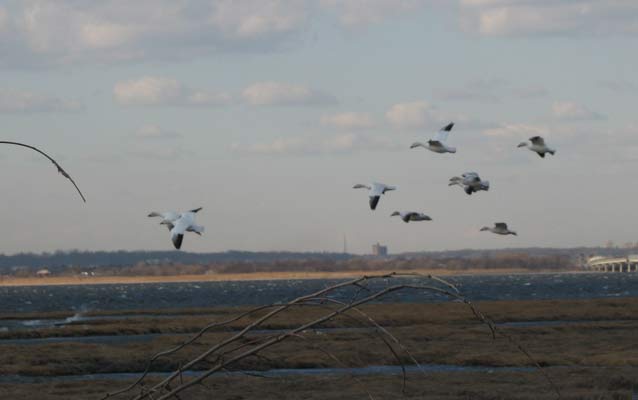Last updated: July 24, 2015
Lesson Plan
Investigating Bird Migration and Climate Change

- Grade Level:
- Middle School: Sixth Grade through Eighth Grade
- Subject:
- Literacy and Language Arts,Science
- Lesson Duration:
- 90 Minutes
- Common Core Standards:
- 5.RI.1, 5.RI.2, 5.RI.3, 5.RI.4, 5.RI.7, 6.RI.1, 6.RI.2, 6.RI.3, 6.RI.4, 6.RI.8, 6.RI.7, 7.RI.1, 7.RI.3, 7.RI.4, 7.RI.8, 8.RI.1, 8.RI.2, 8.RI.3, 9-10.RI.1, 9-10.RI.2, 9-10.RI.4, 6-8.RST.1, 6-8.RST.2, 6-8.RST.3, 6-8.RST.4, 6-8.RST.7, 6-8.RST.9, 9-10.RST.1, 6-8.RST.10, 9-10.RST.2, 9-10.RST.4, 9-10.RST.5, 9-10.RST.8, 9-10.RST.9, 9-10.RST.10
- State Standards:
- NYS learning Standards STEM and The Living Environment Core Curriculum- Grades 9-12
Standard 1.1
Standard 4.1. 4.3
Intermediate Level Science Core Curriculum – Grades 5-8
Standard 4.3, 4.6, 4.7 - Additional Standards:
- Next Generation Science Standards (NGSS) for NY
5-PS3-1.
5-LS1-1.
5-LS2-1.
MS-LS2-2.
MS-ESS3-5 - Thinking Skills:
- Understanding: Understand the main idea of material heard, viewed, or read. Interpret or summarize the ideas in own words. Analyzing: Break down a concept or idea into parts and show the relationships among the parts.
Objective
What makes Jamaica Bay such an important place for birds during migration? How will climate change impact the refuge?
How can we maintain the refuge for generations to come?
Background
In this activity students will discover what a wildlife refuge is and explore this outdoor classroom and laboratory while conducting experiments and gathering data. Students will establish a personal experience with bird species they may see on their visit to the Refuge. As a pre activity the students will create bird identification cards for the two birds. Students will collect data on habitat, weather and tides to better understand the effects of climate change on birds and their habitat. It can be used as one longer lesson or broken down into smaller chunks.
The lesson plan includes activities with reading passages and maps, as wells as analyzing graphs and images. The lessons include various topics on the ecology and wildlife of Jamaica Bay. Topics Include: Biology: Animals, Biology: Plants, Botany, Civic Engagement, Climate, Climate Change, Conservation, Ecological Engineering, Ecology, Environment, Marine Biology, Meteorology, Oceans, Wildlife Biology, Wildlife Management, Writing
The information in the lesson plan packet is designed to acquaint you with the Wildlife Refuge prior to your visit, in order to make the most of your experience.
The National Park Service administers Gateway National Recreation Area.
Our mission is to preserve and protect the natural and cultural resources in the park. Education plays a vital role in the accomplishment of this objective. The foundation of this program is built on the New York City standards and emphasizes hands-on investigation of natural resources.
Our approach to environmental education is interdisciplinary and hands-on.
The success of the program depends on the incorporation of both the pre-site and post site activities, included in this packet. It is extremely important that your students bring the field experience back to the classroom and the home/school environment.
The Wildlife Refuge habitat areas offer the opportunity for exciting investigations of the physical and natural worlds. Our primary goal is to stimulate student’s natural sense of wonder and educate them about their environment.
Preparation
Download lesson plan and print materials for students.
Materials
Download Standards and Objectives Overview
Procedure
Use the detailed lesson plan packet for teacher delivery and student activity instructions.
Vocabulary
Adaptation
Aquatic
Climate
Coast
Coastal upland
Ecosystem
Estuary
Invasive plant
Marine
Meadow
Native plant
Phenology
Phenophases
Refuge
Weather
Additional Resources
USA Phenology Network: www.usanpn.org/
Mid-Atlantic Phenology Network: www.mapseasons.net/
Caduto, Michael J. and J. Bruchac. Keepers of Life: Discovering Plants through Native American Stories and Earth Activities for Children. Fulcrum Publishing. 1998.
Home Is Where the Habitat Is. National Wildlife Federation. 1994
National Research Council. National Science Education Standards. National Academy of Sciences. Washington, D.C. 1996
New York City Standards. 1998.
Ostlund, Karen L. and Addison-Wesley Science. Cooperative Group Strategies For Successful Science Teaching. Ostlund/Addison-Wesley Publishing Company. 1991.
Project Wild Secondary Activity Guide. Western Regional Education Council. 1986.
University of the State of New York, State Education Department. Elementary Science Syllabus. 1992.
Yarrow, Ruth. Exploring Environments. High Rock Conservation Center of the Staten Island Institute of Arts and Sciences. 1979.
Related Lessons or Education Materials
Other Gateway National Recreation Area Lesson Plans
Osprey Migration https://www.nps.gov/gate/learn/education/osprey-migration.htm
Marine Invaders https://www.nps.gov/gate/learn/education/marine-invaders.htm
Asian Shore Crabs https://www.nps.gov/gate/learn/education/asian-shore-crabs.htm
